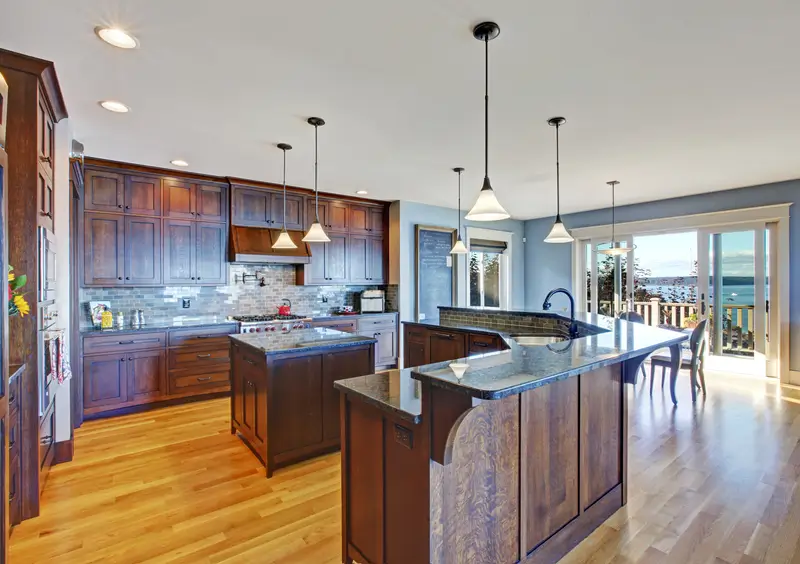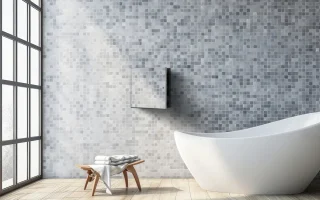If you’re planning a new kitchen or just curious about how high your worktops should be, you’re not alone. “What is the standard kitchen counter height?” is one of the most searched questions by UK homeowners. And for good reason—it’s something you use every day, whether you’re making tea, chopping veg, or unloading the dishwasher.
In this guide, we’ll keep it simple. You’ll learn what the typical kitchen counter height is in the UK, why it matters, and how to make sure it fits your space and your lifestyle.
The Average Height of a Kitchen Counter in the UK
In most UK homes, the standard kitchen counter height is 90 centimetres—that’s 900mm, or about 36 inches. This measurement is taken from the finished floor (tiles, vinyl, or wood) up to the top of the countertop.
This height works well for the average adult. It’s high enough for standing tasks like prepping food and washing up, but low enough to keep things comfortable for everyday use.
Depending on the brand or cabinet supplier, you might see slight differences (usually between 880mm and 920mm), but 90cm is considered the benchmark in British kitchens.
What is the standard height of a kitchen counter?” The answer is: 90cm (900mm) in most modern UK kitchens.
Why 90 cm Is Considered the Optimal Worktop Height
The 90cm height isn’t just a random number. It’s based on years of design research around ergonomics and comfort. For someone between 5’4″ and 5’10” tall, this height lets you work comfortably without stooping or straining your arms.
Too low? Your back will ache. Too high? Your shoulders will tense up. That’s why 90cm tends to hit the sweet spot for most people.
If you’re much taller or shorter, some designers suggest adjusting the counter height by ±5 cm to suit your needs. But if you’re sticking with off-the-shelf cabinets or standard appliances, 90cm is almost always your go-to.
You might also hear it referred to as:
- “typical countertop height”
- “average kitchen counter height”
- “normal kitchen worktop height”
In every case, they all point to the same thing: 900mm from floor to top.
Kitchen Counter Depth – What’s Standard?
While height gets most of the attention, depth plays a big role in how usable your counters actually feel. In the UK, the standard kitchen counter depth is 60 centimetres—or 600mm from the wall to the front edge of the worktop.
This depth gives you enough space for:
- Built-in appliances (like ovens and dishwashers)
- Placing small appliances (kettle, toaster)
- A decent workspace in front of your backsplash
Some kitchen layouts stretch a bit deeper—up to 65 or even 70 cm—especially in bespoke designs or modern renovations. But 60 cm is the default for most standard kitchen cabinets and worktops sold in the UK.
If you’re searching for:
- “What is the standard kitchen counter depth?”
- “How deep is a kitchen countertop?”
- “Standard countertop depth UK”
—then 600mm is the answer.
Tip: For islands and breakfast bars, you’ll often see depths of 90 cm or more, especially if stools are involved.
Counter Height vs Other Work Surfaces
Kitchen counters aren’t the only surfaces you’ll find in your home. So how does the standard 90 cm height compare to other common worktop and seating areas?
Bar Counter Height
Bar-style counters are usually taller—105 to 110 cm (about 41 to 43 inches). This is the right height for bar stools, especially in open-plan kitchens where you want a casual dining space or breakfast bar setup.
Kitchen Table Height
Standard dining tables sit much lower, at around 72 to 75 cm (28 to 30 inches). These are designed for sitting with your feet on the floor and your arms at a comfortable eating or writing height.
Kitchen Islands
Most islands match the standard 90 cm counter height, especially when they’re used for cooking or food prep. But if you’re adding stools or making it more of a bar-style hangout, you might raise it to 105 cm to fit bar stools comfortably.
So, if you’re asking:
- “What’s the difference between counter height and bar height?”
- “How tall is a kitchen island compared to a table?” —you now know where everything lines up.
Factors That Affect Kitchen Counter Height Decisions
While 90 cm is the go-to standard, not every kitchen sticks to the rules. A few key factors can influence whether you stick with the usual height—or go a little higher or lower.
1. Appliance Integration
If you’re installing a built-in oven, dishwasher, or washing machine, your counter height might need to line up with the appliance for a flush fit. Most appliances are designed for a 90 cm counter, but double-check before installing.
2. Flooring Thickness
Your final counter height is measured after the floor goes in. If you’re laying thick tiles or engineered wood flooring, it can raise the surface slightly—something to factor in during planning.
3. Cabinet and Plinth Options
Standard base cabinets are around 72 cm tall, with an 18 cm plinth (kickboard) underneath and a 2–4 cm worktop on top. Custom kitchens may play with these numbers to tweak the overall height.
4. User Height
If someone in your home is very tall or uses a wheelchair, you might want to adjust the height to make cooking and cleaning more comfortable. Even small tweaks—like going up to 94 cm or down to 86 cm—can make a big difference in day-to-day use.
5. Kitchen Type
In multi-height kitchens (especially open-plan layouts), you might have one section at standard height for cooking, and another at bar height for seating. This can help separate zones without using walls.
So, when you’re asking:
- “What affects kitchen counter height?”
- “Can I change the height of my worktops?” —yes, you can. Just make sure it works with your appliances, your floor, and your body.
Are There Different Standards Globally?
Yes—kitchen counter heights vary slightly depending on where you are. If you’ve looked at kitchen design ideas online, you might’ve noticed different dimensions. Here’s how the UK compares:
UK Standard
As mentioned, UK kitchen counters usually sit at 90 cm (900mm). This has been the typical height in British homes for decades and aligns with most UK appliance sizes and cabinet systems.
US Standard
In the United States, the standard is also about 36 inches, which is roughly the same as 91.5 cm. So there’s not a huge difference—just a small adjustment for imperial measurements.
European Standard
Many EU countries follow a similar 90 cm height, though some Scandinavian kitchens may go a touch higher—up to 92–94 cm—to suit taller users and more modern designs.
Why It Matters
If you’re buying flat-pack cabinets or appliances from abroad (IKEA, for example), make sure to double-check the height and base system. Even a 2 cm mismatch can throw off alignment, especially if you’re trying to match up with integrated appliances or splashbacks.
So if you’ve been wondering:
- “Do kitchen counter heights vary by country?”
- “Is UK standard the same as US or EU?” —yes, they’re close, but not always identical. Stick with 90 cm for most UK builds unless you have a good reason to change.
FAQs About Kitchen Countertop Height
What is the standard kitchen countertop height in cm?
In the UK, the standard height is 90 cm, measured from the floor to the top of the counter.
How high should a kitchen worktop be?
Most kitchen worktops should be around 900mm (90 cm) tall. It’s a comfortable height for most people and works well with standard appliances.
Can kitchen counters be made taller or shorter?
Yes, especially in custom kitchens. Taller users might prefer 94 cm, while shorter or seated users may prefer 86–88 cm. Always factor in cabinet, plinth, and worktop thickness.
What is the standard kitchen counter depth?
Typical counter depth is 60 cm (600mm). This suits most appliances and gives enough room to work without overhang.
How does counter height compare to table height?
Dining tables are much lower—usually 72–75 cm—compared to the standard counter height of 90 cm. Bar counters are even taller at 105–110 cm.
Is 36 inches the same as 90 cm?
Pretty much! 36 inches = 91.44 cm, which is very close to the UK standard of 90 cm. Most UK and US counters sit at this height.
Choose Comfort Over Convention
The standard kitchen counter height in the UK is 90 cm, and that works well for most people and most kitchens. It lines up with standard appliances, suits everyday tasks, and keeps your kitchen feeling balanced and practical.
But here’s the thing—you’re not locked into 90 cm. If you’re unusually tall, short, or designing a space for accessibility, don’t be afraid to tweak the height slightly. A few centimetres can make your kitchen more comfortable and more enjoyable to use every day.
Quick Recap:
- Standard height: 90 cm (36 inches)
- Standard depth: 60 cm (24 inches)
- Bar counters: 105–110 cm
- Dining tables: 72–75 cm
- Always measure from the finished floor
- Adjust if needed to suit your body, appliances, or lifestyle
When in doubt? Mock it up. Stack some boxes, grab a board, and try prepping a meal at different heights before committing to a final setup.
Your kitchen should work for you—not the other way around.




